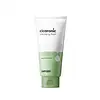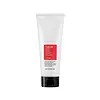What's inside
What's inside
 Key Ingredients
Key Ingredients

 Benefits
Benefits

 Concerns
Concerns

 Ingredients Side-by-side
Ingredients Side-by-side

Water
Skin ConditioningMyristic Acid
CleansingGlycerin
HumectantPotassium Hydroxide
BufferingStearic Acid
CleansingGlyceryl Stearate
EmollientPalmitic Acid
EmollientCocamidopropyl Betaine
CleansingButylene Glycol
HumectantSorbitol
HumectantPotassium Benzoate
PreservativeParfum
MaskingSodium Chloride
MaskingPolyquaternium-7
Acrylates/C10-30 Alkyl Acrylate Crosspolymer
Emulsion StabilisingDisodium EDTA
Arachidic Acid
CleansingLauric Acid
CleansingMelia Azadirachta Leaf Extract
Skin ConditioningCoptis Japonica Root Extract
Skin ConditioningOleic Acid
EmollientSodium Benzoate
MaskingPanthenol
Skin ConditioningMelia Azadirachta Flower Extract
Skin ConditioningPropanediol
SolventCentella Asiatica Leaf Extract
Skin ConditioningCentella Asiatica Extract
CleansingTheobroma Cacao Seed Extract
AntioxidantChamomilla Recutita Flower Extract
MaskingMelissa Officinalis Leaf Extract
Skin ConditioningOriganum Majorana Leaf Extract
AntiseborrhoeicLavandula Angustifolia Flower Extract
CleansingThymus Vulgaris Leaf Extract
Skin ProtectingSalvia Officinalis Leaf Extract
CleansingRosmarinus Officinalis Leaf Extract
AntimicrobialDextrin
Absorbent1,2-Hexanediol
Skin ConditioningAnastatica Hierochuntica Extract
AstringentFragaria Vesca Leaf Extract
AstringentSodium Hyaluronate
HumectantHyaluronic Acid
HumectantHydrolyzed Hyaluronic Acid
HumectantEthylhexylglycerin
Skin ConditioningMadecassoside
AntioxidantWater, Myristic Acid, Glycerin, Potassium Hydroxide, Stearic Acid, Glyceryl Stearate, Palmitic Acid, Cocamidopropyl Betaine, Butylene Glycol, Sorbitol, Potassium Benzoate, Parfum, Sodium Chloride, Polyquaternium-7, Acrylates/C10-30 Alkyl Acrylate Crosspolymer, Disodium EDTA, Arachidic Acid, Lauric Acid, Melia Azadirachta Leaf Extract, Coptis Japonica Root Extract, Oleic Acid, Sodium Benzoate, Panthenol, Melia Azadirachta Flower Extract, Propanediol, Centella Asiatica Leaf Extract, Centella Asiatica Extract, Theobroma Cacao Seed Extract, Chamomilla Recutita Flower Extract, Melissa Officinalis Leaf Extract, Origanum Majorana Leaf Extract, Lavandula Angustifolia Flower Extract, Thymus Vulgaris Leaf Extract, Salvia Officinalis Leaf Extract, Rosmarinus Officinalis Leaf Extract, Dextrin, 1,2-Hexanediol, Anastatica Hierochuntica Extract, Fragaria Vesca Leaf Extract, Sodium Hyaluronate, Hyaluronic Acid, Hydrolyzed Hyaluronic Acid, Ethylhexylglycerin, Madecassoside
Water
Skin ConditioningMyristic Acid
CleansingSodium Chloride
MaskingEthyl Hexanediol
SolventCocamidopropyl Betaine
CleansingCitrus Limon Fruit Oil
AstringentSodium Methyl Cocoyl Taurate
CleansingEthylhexylglycerin
Skin ConditioningStearic Acid
CleansingPEG-60 Hydrogenated Castor Oil
EmulsifyingPolysorbate 80
EmulsifyingCaprylyl Glycol
EmollientGlycerin
HumectantPotassium Hydroxide
BufferingSalicylic Acid
MaskingLauric Acid
CleansingButylene Glycol
HumectantSalix Alba Bark Water
Astringent1,2-Hexanediol
Skin ConditioningDisodium EDTA
Glycol Distearate
EmollientMelaleuca Alternifolia Leaf Oil
AntioxidantCitric Acid
BufferingWater, Myristic Acid, Sodium Chloride, Ethyl Hexanediol, Cocamidopropyl Betaine, Citrus Limon Fruit Oil, Sodium Methyl Cocoyl Taurate, Ethylhexylglycerin, Stearic Acid, PEG-60 Hydrogenated Castor Oil, Polysorbate 80, Caprylyl Glycol, Glycerin, Potassium Hydroxide, Salicylic Acid, Lauric Acid, Butylene Glycol, Salix Alba Bark Water, 1,2-Hexanediol, Disodium EDTA, Glycol Distearate, Melaleuca Alternifolia Leaf Oil, Citric Acid
 Reviews
Reviews

Ingredients Explained
These ingredients are found in both products.
Ingredients higher up in an ingredient list are typically present in a larger amount.
1,2-Hexanediol is a synthetic liquid and another multi-functional powerhouse.
It is a:
- Humectant, drawing moisture into the skin
- Emollient, helping to soften skin
- Solvent, dispersing and stabilizing formulas
- Preservative booster, enhancing the antimicrobial activity of other preservatives
Butylene Glycol (or BG) is used within cosmetic products for a few different reasons:
Overall, Butylene Glycol is a safe and well-rounded ingredient that works well with other ingredients.
Though this ingredient works well with most skin types, some people with sensitive skin may experience a reaction such as allergic rashes, closed comedones, or itchiness.
Learn more about Butylene GlycolCocamidopropyl Betaine is a fatty acid created by mixing similar compounds in coconut oil and dimethylaminopropylamine, a compound with two amino groups.
This ingredient is a surfactant and cleanser. It helps gather the dirt, pollutants, and other impurities in your skin to be washed away. It also helps thicken a product and make the texture more creamy.
Being created from coconut oil means Cocamidopropyl Betaine is hydrating for the skin.
While Cocamidopropyl Betaine was believed to be an allergen, a study from 2012 disproved this. It found two compounds in unpure Cocamidopropyl Betaine to be the irritants: aminoamide and 3-dimethylaminopropylamine. High-grade and pure Cocamidopropyl Betaine did not induce allergic reactions during this study.
Learn more about Cocamidopropyl BetaineDisodium EDTA plays a role in making products more stable by aiding other preservatives.
It is a chelating agent, meaning it neutralizes metal ions that may be found in a product.
Disodium EDTA is a salt of edetic acid and is found to be safe in cosmetic ingredients.
Learn more about Disodium EDTAEthylhexylglycerin (we can't pronounce this either) is commonly used as a preservative and skin softener. It is derived from glyceryl.
You might see Ethylhexylglycerin often paired with other preservatives such as phenoxyethanol. Ethylhexylglycerin has been found to increase the effectiveness of these other preservatives.
Glycerin is already naturally found in your skin. It helps moisturize and protect your skin.
A study from 2016 found glycerin to be more effective as a humectant than AHAs and hyaluronic acid.
As a humectant, it helps the skin stay hydrated by pulling moisture to your skin. The low molecular weight of glycerin allows it to pull moisture into the deeper layers of your skin.
Hydrated skin improves your skin barrier; Your skin barrier helps protect against irritants and bacteria.
Glycerin has also been found to have antimicrobial and antiviral properties. Due to these properties, glycerin is often used in wound and burn treatments.
In cosmetics, glycerin is usually derived from plants such as soybean or palm. However, it can also be sourced from animals, such as tallow or animal fat.
This ingredient is organic, colorless, odorless, and non-toxic.
Glycerin is the name for this ingredient in American English. British English uses Glycerol/Glycerine.
Learn more about GlycerinLauric Acid is a fatty acid or lipid. About half of fatty acids in coconut oil is lauric acid.
This ingredient helps hydrate and sooth skin. As a humectant, it helps trap moisture. It also aids in cleaning and enhancing the texture of products.
Lauric acid may not be Malassezia folliculitis, or fungal acne, safe.
Learn more about Lauric AcidMyristic Acid is a saturated fatty acid. It is naturally found in milk fat. Other sources include palm oil, coconut oil, and butter fat.
Myristic Acid is an emulsifer and cleanser. As an emulsifer, it stabilizes a product by preventing ingredients from separating. Myristic Acid helps clean your skin by acting as a surfactant. It tends to gather oil and dirt on your skin to be easily rinsed away.
One study from 2021 found Myristic Acid to have anti-inflammatory properties.
Learn more about Myristic AcidPotassium hydroxide is commonly known as caustic potash. It is used to fix the pH of a product or as a cleaning agent in soap. In cleansers, it is used for the saponification of oils.
Sapnification is the process of creating fatty acid metal salts from triglycerides and a strong base. During this process, Potassium Hydroxide is used up and is not present in the final product.
Using high concentrations of Potassium Hydroxide have shown to irritate the skin.
Learn more about Potassium HydroxideChances are, you eat sodium chloride every day. Sodium Chloride is also known as table salt.
This ingredient has many purposes in skincare: thickener, emulsifier, and exfoliator.
You'll most likely find this ingredient in cleansers where it is used to create a gel-like texture. As an emulsifier, it also prevents ingredients from separating.
There is much debate on whether this ingredient is comedogenic. The short answer - comedogenic ratings don't tell the whole story. Learn more about comegodenic ratings here.
The concensus about this ingredient causing acne seems to be divided. Research is needed to understand if this ingredient does cause acne.
Scrubs may use salt as the primary exfoliating ingredient.
Learn more about Sodium ChlorideStearic Acid is a fatty acid. It is an emollient, emulsifier, and texture enhancer.
As an emollient, stearic acid helps soften skin. It aids the skin's protective barrier by preventing water loss. It also provides a gentle cleansing effect without stripping away natural oils.
Stearic acid may also be used to enhance the texture of products. It can add volume and stabilize ingredients such as water and oil. This can help water and oil ingredients from separating.
Sources of stearic acid include animal or vegetable fats/oils such as coconut or shea. It can be naturally found in butter, cocoa butter, shea butter, vegetable fats, and animal tallow.
This ingredient may not be Malassezia folliculitis, or fungal-acne safe.
Learn more about Stearic AcidWater. It's the most common cosmetic ingredient of all. You'll usually see it at the top of ingredient lists, meaning that it makes up the largest part of the product.
So why is it so popular? Water most often acts as a solvent - this means that it helps dissolve other ingredients into the formulation.
You'll also recognize water as that liquid we all need to stay alive. If you see this, drink a glass of water. Stay hydrated!
Learn more about Water